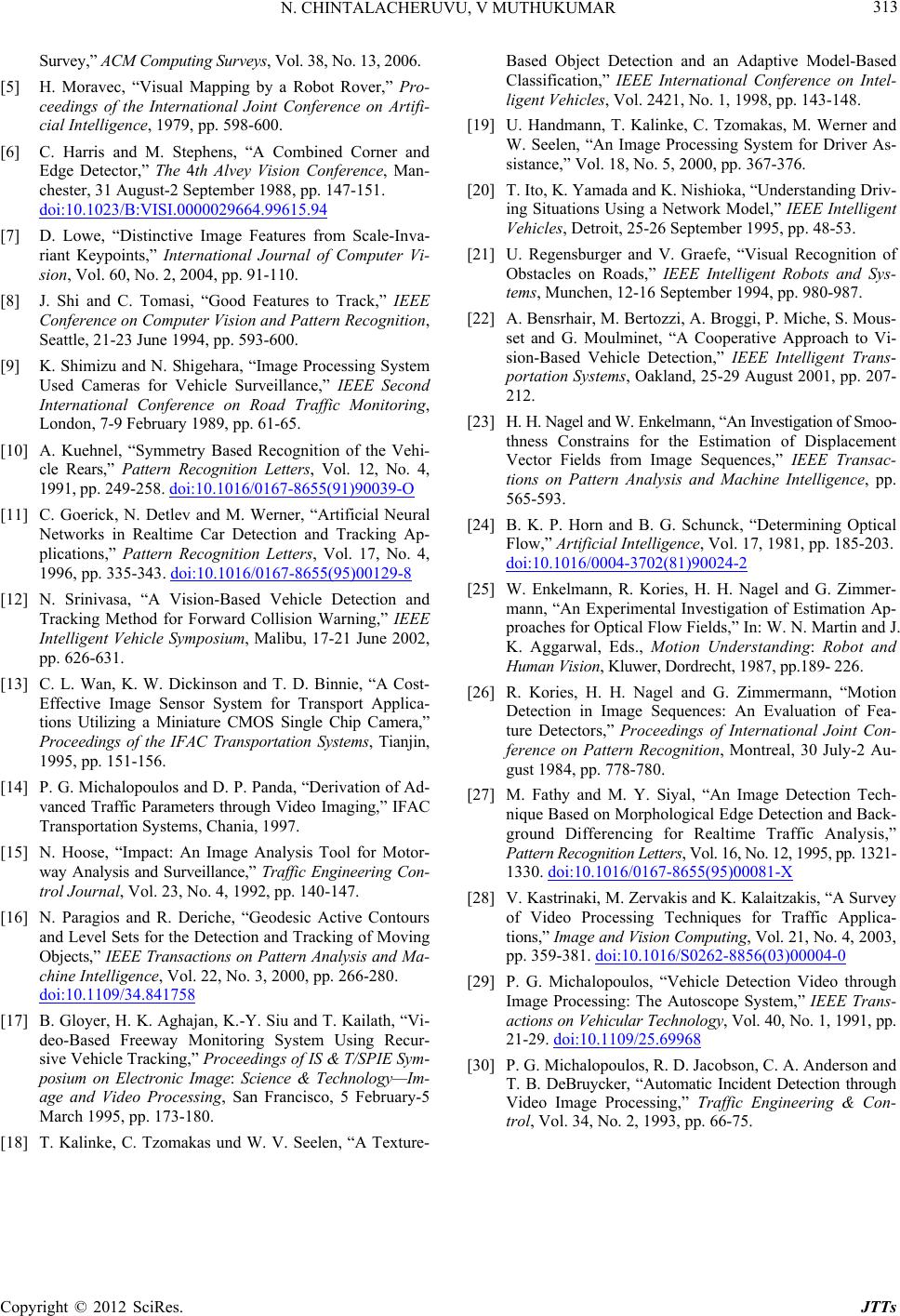
N. CHINTALACHERUVU, V MUTHUKUMAR 313
Survey,” ACM Computing Surveys, Vol. 38, No. 13, 2006.
[5] H. Moravec, “Visual Mapping by a Robot Rover,” Pro-
ceedings of the International Joint Conference on Artifi-
cial Intelligence, 1979, pp. 598-600.
[6] C. Harris and M. Stephens, “A Combined Corner and
Edge Detector,” The 4th Alvey Vision Conference, Man-
chester, 31 August-2 September 1988, pp. 147-151.
doi:10.1023/B:VISI.0000029664.99615.94
[7] D. Lowe, “Distinctive Image Features from Scale-Inva-
riant Keypoints,” International Journal of Computer Vi-
sion, Vol. 60, No. 2, 2004, pp. 91-110.
[8] J. Shi and C. Tomasi, “Good Features to Track,” IEEE
Conference on Computer Vision and Pattern Recognition,
Seattle, 21-23 June 1994, pp. 593-600.
[9] K. Shimizu and N. Shigehara, “Image Processing System
Used Cameras for Vehicle Surveillance,” IEEE Second
International Conference on Road Traffic Monitoring,
London, 7-9 February 1989, pp. 61-65.
[10] A. Kuehnel, “Symmetry Based Recognition of the Vehi-
cle Rears,” Pattern Recognition Letters, Vol. 12, No. 4,
1991, pp. 249-258. doi:10.1016/0167-8655(91)90039-O
[11] C. Goerick, N. Detlev and M. Werner, “Artificial Neural
Networks in Realtime Car Detection and Tracking Ap-
plications,” Pattern Recognition Letters, Vol. 17, No. 4,
1996, pp. 335-343. doi:10.1016/0167-8655(95)00129-8
[12] N. Srinivasa, “A Vision-Based Vehicle Detection and
Tracking Method for Forward Collision Warning,” IEEE
Intelligent Vehicle Symposium, Malibu, 17-21 June 2002,
pp. 626-631.
[13] C. L. Wan, K. W. Dickinson and T. D. Binnie, “A Cost-
Effective Image Sensor System for Transport Applica-
tions Utilizing a Miniature CMOS Single Chip Camera,”
Proceedings of the IFAC Transportation Systems, Tianjin,
1995, pp. 151-156.
[14] P. G. Michalopoulos and D. P. Panda, “Derivation of Ad-
vanced Traffic Parameters through Video Imaging,” IFAC
Transportation Systems, Chania, 1997.
[15] N. Hoose, “Impact: An Image Analysis Tool for Motor-
way Analysis and Surveillance,” Traffic Engineering Con-
trol Journal, Vol. 23, No. 4, 1992, pp. 140-147.
[16] N. Paragios and R. Deriche, “Geodesic Active Contours
and Level Sets for the Detection and Tracking of Moving
Objects,” IEEE Transactions on Pattern Analysis and Ma-
chine Intelligence, Vol. 22, No. 3, 2000, pp. 266-280.
doi:10.1109/34.841758
[17] B. Gloyer, H. K. Aghajan, K.-Y. Siu and T. Kailath, “Vi-
deo-Based Freeway Monitoring System Using Recur-
sive Vehicle Tracking,” Proceedings of IS & T/SPIE Sym-
posium on Electronic Image: Science & Technology—Im-
age and Video Processing, San Francisco, 5 February-5
March 1995, pp. 173-180.
[18] T. Kalinke, C. Tzomakas und W. V. Seelen, “A Texture-
Based Object Detection and an Adaptive Model-Based
Classification,” IEEE International Conference on Intel-
ligent Vehicles, Vol. 2421, No. 1, 1998, pp. 143-148.
[19] U. Handmann, T. Kalinke, C. Tzomakas, M. Werner and
W. Seelen, “An Image Processing System for Driver As-
sistance,” Vol. 18, No. 5, 2000, pp. 367-376.
[20] T. Ito, K. Yamada and K. Nishioka, “Understanding Driv-
ing Situations Using a Network Model,” IEEE Intelligent
Vehicles, Detroit, 25-26 September 1995, pp. 48-53.
[21] U. Regensburger and V. Graefe, “Visual Recognition of
Obstacles on Roads,” IEEE Intelligent Robots and Sys-
tems, Munchen, 12-16 September 1994, pp. 980-987.
[22] A. Bensrhair, M. Bertozzi, A. Broggi, P. Miche, S. Mous-
set and G. Moulminet, “A Cooperative Approach to Vi-
sion-Based Vehicle Detection,” IEEE Intelligent Trans-
portation Systems, Oakland, 25-29 August 2001, pp. 207-
212.
[23] H. H. Nagel and W. Enkelmann, “An Investigation of Smoo-
thness Constrains for the Estimation of Displacement
Vector Fields from Image Sequences,” IEEE Transac-
tions on Pattern Analysis and Machine Intelligence, pp.
565-593.
[24] B. K. P. Horn and B. G. Schunck, “Determining Optical
Flow,” Artificial Intelligence, Vol. 17, 1981, pp. 185-203.
doi:10.1016/0004-3702(81)90024-2
[25] W. Enkelmann, R. Kories, H. H. Nagel and G. Zimmer-
mann, “An Experimental Investigation of Estimation Ap-
proaches for Optical Flow Fields,” In: W. N. Martin and J.
K. Aggarwal, Eds., Motion Understanding: Robot and
Human Vision, Kluwer, Dordrecht, 1987, pp.189- 226.
[26] R. Kories, H. H. Nagel and G. Zimmermann, “Motion
Detection in Image Sequences: An Evaluation of Fea-
ture Detectors,” Proceedings of International Joint Con-
ference on Pattern Recognition, Montreal, 30 July-2 Au-
gust 1984, pp. 778-780.
[27] M. Fathy and M. Y. Siyal, “An Image Detection Tech-
nique Based on Morphological Edge Detection and Back-
ground Differencing for Realtime Traffic Analysis,”
Pattern Recognition Letters, Vol. 16, No. 12, 1995, pp. 1321-
1330. doi:10.1016/0167-8655(95)00081-X
[28] V. Kastrinaki, M. Zervakis and K. Kalaitzakis, “A Survey
of Video Processing Techniques for Traffic Applica-
tions,” Image and Vision Computing, Vol. 21, No. 4, 2003,
pp. 359-381. doi:10.1016/S0262-8856(03)00004-0
[29] P. G. Michalopoulos, “Vehicle Detection Video through
Image Processing: The Autoscope System,” IEEE Trans-
actions on Vehicular Technology, Vol. 40, No. 1, 1991, pp.
21-29. doi:10.1109/25.69968
[30] P. G. Michalopoulos, R. D. Jacobson, C. A. Anderson and
T. B. DeBruycker, “Automatic Incident Detection through
Video Image Processing,” Traffic Engineering & Con-
trol, Vol. 34, No. 2, 1993, pp. 66-75.
Copyright © 2012 SciRes. JTTs